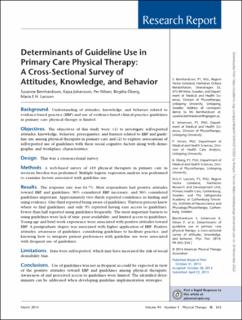| dc.contributor.author | Bernhardsson, S. | |
| dc.contributor.author | Johansson, K. | |
| dc.contributor.author | Nilsen, P. | |
| dc.contributor.author | Öberg, B. | |
| dc.contributor.author | Larsson, M. E. | |
| dc.date.accessioned | 2022-11-30T13:28:33Z | |
| dc.date.available | 2022-11-30T13:28:33Z | |
| dc.date.issued | 2014 | |
| dc.identifier.citation | Bernhardsson, S., Johansson, K., Nilsen, P., Öberg, B. & Larsson, M. E. (2014). Determinants of guideline use in primary care physical therapy: a cross-sectional survey of attitudes, knowledge, and behavior. Physical therapy, 94(3), 343–354. | en_US |
| dc.identifier.uri | https://hdl.handle.net/11250/3035096 | |
| dc.description.abstract | Background
Understanding of attitudes, knowledge, and behavior related to evidence-based practice (EBP) and use of evidence-based clinical practice guidelines in primary care physical therapy is limited.
Objectives
The objectives of this study were: (1) to investigate self-reported attitudes, knowledge, behavior, prerequisites, and barriers related to EBP and guideline use among physical therapists in primary care and (2) to explore associations of self-reported use of guidelines with these social cognitive factors along with demographic and workplace characteristics.
Design
This was a cross-sectional survey.
Methods
A web-based survey of 419 physical therapists in primary care in western Sweden was performed. Multiple logistic regression analysis was performed to examine factors associated with guideline use.
Results
The response rate was 64.7%. Most respondents had positive attitudes toward EBP and guidelines: 90% considered EBP necessary, and 96% considered guidelines important. Approximately two thirds reported confidence in finding and using evidence. One third reported being aware of guidelines. Thirteen percent knew where to find guidelines, and only 9% reported having easy access to guidelines. Fewer than half reported using guidelines frequently. The most important barriers to using guidelines were lack of time, poor availability, and limited access to guidelines. Young age and brief work experience were associated with positive attitudes toward EBP. A postgraduate degree was associated with higher application of EBP. Positive attitudes, awareness of guidelines, considering guidelines to facilitate practice, and knowing how to integrate patient preferences with guideline use were associated with frequent use of guidelines.
Limitations
Data were self-reported, which may have increased the risk of social desirability bias.
Conclusions
Use of guidelines was not as frequent as could be expected in view of the positive attitudes toward EBP and guidelines among physical therapists. Awareness of and perceived access to guidelines were limited. The identified determinants can be addressed when developing guideline implementation strategies. | en_US |
| dc.publisher | Physical therapy | en_US |
| dc.subject | evidence-based practice | en_US |
| dc.subject | professional issues | en_US |
| dc.subject | implementering | en_US |
| dc.subject | retningslinjer | en_US |
| dc.subject | veiledere | en_US |
| dc.title | Determinants of guideline use in primary care physical therapy: a cross-sectional survey of attitudes, knowledge, and behavior | en_US |
| dc.type | Journal article | en_US |
| dc.source.pagenumber | 343–354 | en_US |
| dc.source.volume | 94 | en_US |
| dc.source.journal | Physical therapy | en_US |
| dc.source.issue | 3 | en_US |
| dc.identifier.doi | https://doi.org/10.2522/ptj.20130147 | |
